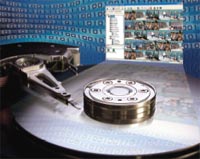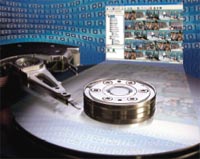
More in Store
New requirements change how IP video is archived
- By Barry Keepence
- Apr 02, 2008

Many organizations now
require that CCTV
video images are recorded and archived
continuously from all cameras for 90
days or more. In large systems, this can
create a significant storage requirement.
The issue is compounded by users wanting
to store video at the highest quality
and maximum frame rate, particularly in
homeland security and law enforcement
applications where CCTV footage is
required for evidential purposes.
The storage element of a large IPCCTV
system can therefore dominate the
overall cost of the system—both upfront
and throughout its lifecycle—as hard
drives will often need to be replaced.
With potentially large amounts of data
stored, the technology behind the compression
and architecture of the storage
solution is critical to ensure extended
recording times. Similarly, the security of
the stored data is important so individual
disk and equipment failures do not result
in data loss.
The Scale of the Problem
The factors that affect how much disk storage
is required are video resolution, frame
rate, number of cameras and the quality of
the compression technology. So when
comparing systems, the main variable is
the compression technology, as all other
factors are constant. The way in which
video is compressed can make a significant
difference to the storage requirements.
The following example demonstrates
the storage requirements for a typical
system, comparing equipment that has an
average compression with the very best
that is available. The difference between
an average compression and the best is
180 terabytes of extra storage—and
that’s just for a relatively small system of
100 cameras.
NVR Performance
In storage, CCTV systems differ from IT
systems. The amount of data coming
continuously from the cameras to the
NVRs is huge. The amount of data going
from the NVR to the users is low and
periodic. The workload is constant—the
rate of writing data to the disk is always
high—not in bursts as with typical IT
applications.
The processing overhead for writing
and reading the video streams to disk is
therefore important in NVR performance.
There can be a considerable difference
in this overhead between different
vendors of NVR software. Software can
ease the process and will be able to handle
many more camera streams per
NVR. The best NVR server software on
the market has such a low CPU loading
that 200 camera streams can be recorded
on the lowest specification server PC.
Therefore, in a large system with a
90-day recording requirement, the limitation
on the server is its storage, not its
processing power.
Storage Architectures
The storage architecture for CCTV systems
can be categorized as either centralized
or distributed.
A typical example of a centralized
system would be a casino, where numerous
cameras are located in one building.
The NVRs would be located in one central
IT facility, with a central network
switch. In this situation, all of the video
could be recorded on one server;
however, this would be storage-limited,
not CPU-limited.
With a 100-camera system, one option
would be to use 10 NVR servers, each fitted
with an 18-terabyte disk array, assuming
the system has the best compression
technology available. This is still a lot of
hardware, but because the CPU use is
low, virtual servers can be deployed.
Leading NVR vendors can run their software
under applications such as VMware,
allowing 10 virtual servers to be configured
on one physical server and considerably
reducing equipment costs. In reality,
the typical casino uses between 500 and
1,000 cameras, so this approach is an
important factor in lowering costs.
A typical example of a distributed system
would be a rail network that could
have 200 cameras located across 25 stations
with, on average, eight cameras per
station, with some stations only having
four cameras. In this situation, what is
needed is a small and flexible storage
architecture that can use the right amount
of storage for the right number of cameras.
For this example, assume 500 gigabytes
per camera is required for 90-day
recording. An NVR with 2 terabytes
could be deployed at each station, with
one NVR per four cameras. The smaller
stations would have one NVR, and the
larger ones would have five, for a total of
50 NVRs for all 200 cameras. This would
significantly reduce the bandwidth
requirement. The flexibility of the virtual
matrix created by the IP video system
means users with the right permissions
could view and analyze recorded video
from any NVR, no matter where on the
network they are located.
If PC-based servers were used in the
example above, then 50 separate servers
would be required, each with local
attached storage, which comes at a significant
cost. An alternative would be to use
dedicated, stand-alone NVR units that have the processing hardware and storage
in a single compact unit. These are considerably
less expensive than a PC server
and equivalent storage.
To satisfy different types of applications,
a vendor needs to be able to provide
a flexible and scalable recording solution
that can use both PC server configurations
and dedicated NVR units as appropriate.
Data Security
With so much valuable data being recorded,
it’s important to consider NVR security
and reliability. Most PC-based NVR
servers will deploy a redundant array of
independent drive disk arrays. RAID is
an umbrella term for computer data storage
schemes that divide and/or replicate
data among multiple hard drives.
Different RAID levels give different levels
of protection. In a RAID 5 configuration,
for example, the data is stripped
across three separate disks. If any disk
fails, no data is lost and the computer can
continue without interruption.
To take NVR security a level further,
dedicated NVR hardware can be
deployed. These stand-alone robust hardware
units can have redundant power supplies
and network connections, RAID
configurations and hot-swappable drives.
An IP video system that deploys standalone
NVR units also should have a flexible
NVR backup strategy. For example,
if an NVR failure is detected by the system
software, then recordings can be
automatically switched to a backup NVR
or distributed to other NVRs in the system.
Like RAID configurations in PCs,
NVRs can be mirrored, with the same
video being recorded on two NVRs
simultaneously, providing the highest
level of security.
IP video systems based on H.264 can
reduce the amount of storage required by
between 25 and 50 percent, compared to
MPEG-4 based systems.
DVR v. NVR
Storage issues with IP video systems and NVRs have been
discussed, but what about traditional analog CCTV systems
that use DVRs? It is important to differentiate between
DVRs and NVRs, as both are often termed digital.
A DVR digitally compresses analog video feeds and
stores them on a hard drive, with the term digital referring
to the compression and storage technology, not the
transmitted video images. The DVR therefore has to be
located near the analog feeds and is only really used in
centralized architectures. In contrast, an NVR stores digital
images directly from the IP network and can be
located anywhere on the network.
It is typical for a DVR to be located centrally, close to
the analog matrix and control room equipment. As the
size of the system and the number of recording days
increases, there is no other option but to keep adding
DVRs. This, in itself, is not a problem—other than the
cost overhead associated with the DVR. A high-end
DVR typically would be able to record 16 cameras onto
a 2 terabyte disk. Using the example for a casino and
assuming the best compression available, this would
give a little over six days of recording for all 16 cameras,
or 90 days for just one camera.
Clearly, DVR technology is simply too expensive for
large-scale digital recording applications.
Up to Standard
There are a number of compression standards currently
employed in IP video systems. H.264 is the latest
official video compression standard, which follows the
MPEG-2 and MPEG-4 video standards and offers
improvements in both video quality and compression.
The most significant benefit for IP video systems is the
ability to deliver the same high-quality, low-latency
digital video with savings of between 25 and 50 percent
on bandwidth and storage requirements. By selecting a
system based on H.264, further storage savings can be
achieved. Even though H.264 is more efficient than
MPEG-4, there are still differences between vendor
implementation of the standard and the storage
required.
There is no point in recording video from a camera
at full frame rate if there is nothing in the scene to
record. By using applications such as IndigoVision’s
unique, actively controlled frame rate, the amount of
video and storage can be reduced. When a scene is
inactive, the video can be streamed at a much lower
frame rate.
As soon as the motion analysis software detects
movement, the video is streamed at full frame rate.
Similarly, analytics such as virtual tripwire can detect
an object crossing a line and raise an alarm. This alarm
can start recording or increase the frame rate from that
particular camera.
The requirement to record CCTV images for 90 or
more days will have a large impact on the storage
requirement and cost of the project. With larger
systems, the inflexibility and costs
involved with an analog/DVR
solution mean IP video is the only
way forward.
About the Author
Barry Keepence is the chief technical officer at IndigoVision.